Author Spotlight on James Sutter
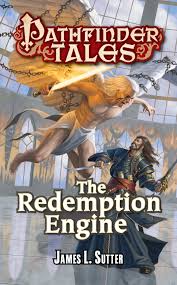 I recently got a chance to talk with my friend (and editor) James Sutter about his new novel, The Redemption Engine, which debuts this week. In this wide-ranging and honest Q&A, James talked about his book and characters, the writing process, misperceptions about genre fiction — particularly of the tie-in flavor — and his hopes and dreams.
I recently got a chance to talk with my friend (and editor) James Sutter about his new novel, The Redemption Engine, which debuts this week. In this wide-ranging and honest Q&A, James talked about his book and characters, the writing process, misperceptions about genre fiction — particularly of the tie-in flavor — and his hopes and dreams.
What would you say to someone wary of reading game fiction? (I would personally point them towards your first novel, Death’s Heretic, being number three on the Barnes & Noble Book Club’s 2011 Best Fantasy list.) But what would you say?
I would say that I used to be wary of it, too. As a kid, I read a ton of tie-in novels for properties like Star Wars, Dragonlance, etc. Then I got older and snobbier, and decided that anything with a logo couldn’t possibly be quality art. I won’t pretend there wasn’t evidence for that — a lot of tie-in books aren’t great. But as Theodore Sturgeon taught us, a lot of any art form isn’t great.
Once I started working in the game industry and realized just how many fabulous authors have done or currently do tie-in work, my opinion changed again. When you’ve got folks like Brandon Sanderson and Greg Bear writing tie-in novels, can you really claim that they’re somehow going to lose their chops just for that one book? And the truth is that great authors have always written novelizations, scripts, tie-ins, and other work-for-hire. Hell, Isaac Asimov himself wrote the novelization for Fantastic Voyage.
In some cases, tie-in work is actually the best of all worlds. Think about it: if you’re an author who’s great with plot and characters but isn’t much of a world-builder, what could be better than having a whole team of other brilliant authors creating your setting and magic system for you? It’s not for every writer, but for some, it’s the chance to shine brighter than ever.
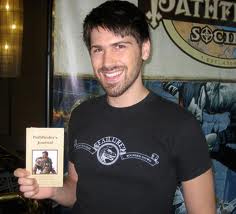
What’s your elevator pitch description of The Redemption Engine?
The elevator pitches for Death’s Heretic were “Blade Runner meets Dante’s Inferno” and “an atheist in a world where gods are objectively real, forced to work as an enforcer for the death goddess.” I’d say that both of those still apply to this book, so if someone had never read Death’s Heretic, I’d probably be sneaky and reuse them.
That said, for folks who did read the first book, this one is all about questions of morality. So I’d ask: “If you could magically turn evil people good without their consent, would that be a miracle, or the worst sort of crime?”
This is your second outing with Salim – has he changed since his last adventure?
Somewhat! Coming up with his character arc for this one was actually a real challenge. In the first book, there’s a lot of revelation about how he got to be the way he is, as well as a love story and the shedding of some of his prejudices (both against other people and against himself). But while I want him to change and grow over the course of the series, I didn’t want to make it too fast. After all, if Batman gets over his issues and hangs up his cape after two issues, he’s not nearly as interesting, right?
In this book, there’s no love interest for Salim, and it’s much more about his personal journey. For the longest time, he’s been defined by his rage against Pharasma (the death goddess). In this book, though, he begins to question a lot of things he’s been taking for granted, particularly his own moral code. That’s what this book is really about: the endlessly complicated nature of right and wrong. (And, you know, crazy monsters and magic.)
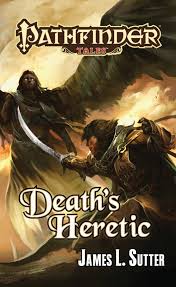 One of the things that most impressed me with your first book was the way you handled extra-planar journeys. You evoked an almost Vancian level of wonder, rife with strange and fascinating detail. Should we expect to see some of the same in The Redemption Engine?
One of the things that most impressed me with your first book was the way you handled extra-planar journeys. You evoked an almost Vancian level of wonder, rife with strange and fascinating detail. Should we expect to see some of the same in The Redemption Engine?
Wow, that’s an incredible compliment! Thank you!
You’ll definitely find plenty of “setting porn” again in this book—I suspect that may be true of every book I write. Weird worlds, bizarre creatures, and unusual cultures are the whole reason I read science fiction and fantasy, and as a co-creator of the Pathfinder campaign setting, worldbuilding is probably the authorial skill I’ve had the most practice with.
So what does that mean for this book? While Death’s Heretic dealt a lot with the planes of law and chaos—the perfect city of Axis and the swirling Maelstrom—this book is really my ode to Dante, and focuses primarily on Heaven and Hell. I should note that, as with all tie-in writers, I got to stand on some giant shoulders for this, especially Paizo’s Managing Editor, F. Wesley Schneider, who’s the primary architect of Hell in our setting.
This time, however, the weirdness isn’t restricted to the Outer Planes of the afterlife. A lot of this book takes place on the mortal plane as well, in the anarchic city of Kaer Maga. Kaer Maga is one of the areas of the Pathfinder setting I had the honor of building from the ground up, and as a result it has a sort of Perdido Street Station/Mos Eisely feel. There’s no government, just competing factions and gangs that balance each other out, and there are all sorts of unusual folks: bloatmages who overload their circulatory systems in order to wring extra magic out of their blood, regenerating trolls who read the future in their own entrails, Sweettalkers who sew their own lips shut so that they won’t use the divine gift of speech for impious purposes — you get the idea. You probably wouldn’t want to live there, but it’s a fun place to visit, and I had a blast introducing Salim to the city’s oddities.
When did you know you wanted to be a writer, and was there a particular work that inspired you more than others?
Always. I can remember being maybe eight years old and banging out ten-page “novels” on my parents’ manual typewriter. That said, public school sure did its best to beat the love out of me. What on earth makes us think that the best way to teach kids to love the written word is by making them analyze stodgy “classics” and write reports? Let them learn that sort of writing in science or history — unless we can show kids the fun side of reading and writing, we’re never going to hook them. Fortunately, I had a couple of teachers in there that understood. I’ve never forgotten my English 101 professor saying, “You all know how to write a good report, properly citing three facts for each body thesis? Good. Now forget all that. A computer could write that. Let’s work on writing that makes someone feel something.” And suddenly it was like I could breathe again.
As far as influences go, I don’t think there’s a single book that can claim the throne. I read constantly as a child, sometimes ten hours a day during the summer, and as result read pretty much whatever I could get my hands on. (For instance, during the summer where a primary source of books was my babysitter’s daughter, I read about a hundred Babysitters’ Club novels…) I do remember my first fantasy novel, though—Richard A. Knaak’s The Crystal Dragon, which caught my eye because of the holographic cover. Other seminal SF authors for me included Patricia C. Wrede, Joel Rosenberg, Michael Crichton, Robert Jordan, Piers Anthony, and Dan Simmons. And Tolkien, of course, but it took me several tries to get through the first half of The Fellowship of the Ring. (Call me a heretic, but the movies were right to leave ol’ Tom Bombadil out.)
What do you like best about the world of Golarion? Are there favorite land features, or countries, or political situations?
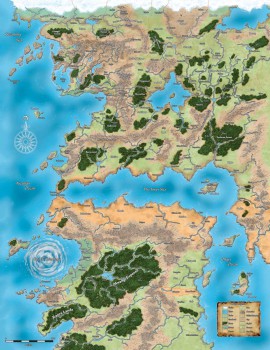
Lazzaretti.
While it might sound arrogant to say “the parts I’ve worked most on!”, it’s actually a self-fulfilling prophecy, because one of the perks of being both Managing Editor and a co-creator is getting to help design those things that interest me the most. My loves are many: the solar system, the First World of the fey, Kaer Maga, Rahadoum the atheist nation, the Outer Planes in general… it’s hard to choose!
One easy way to tell if an area holds particular interest for me is whether it comes with interesting moral or philosophical conundrums. For instance, I got to create the island nation of Hermea, where a gold dragon (traditionally a “good” race) is trying to build a human utopia through selective breeding. From the very beginning, this raised hackles (one of my coworkers derisively dubbed it “Operation Dragon Hitler”), and the message boards still debate whether you can really have a good dragon in charge of a eugenics program, even one which all participants have entered into freely. That sort of ambiguity is inherently interesting to me.
But that’s not to say that I’ve managed to dibs everything I like about Golarion! I’m continually fascinated by what my coworkers and freelancers come up with, and particularly adore the esoteric and extraplanar stuff that folks like Wes Schneider, James Jacobs, Erik Mona, and the rest of the team have given birth to. It’s a privilege to work with such great minds.
How do you manage to wear so many hats and get so much work done? You’ve got an impressive list of accomplishments for someone who just turned 30, not the least of which is managing Paizo’s editorial department and the Pathfinder Tales line full-time. How do you work in time for writing?

Panic over my own inevitable mortality? A desperate desire for validation?
There’s actually more truth to that joke than I’d like to admit. I’ve always had a strong work ethic, and I get really anxious if I don’t feel like I’m being “productive” enough. It’s absurdly easy in our society to value yourself in terms of what you produce—how much money you make, how much prestige you’ve garnered, how many books you’ve sold, etc.—and it’s the siren call of the workaholic. Fortunately, over the last few years, I’ve been getting better at balancing things. If I have one piece of advice for other writers, it’s this: There’s always going to be someone out there better/faster/more accomplished than you, and your friends don’t give a good goddamn how many books you’ve published, just what kind of person you are. Adjust your priorities accordingly.
Oh, and I try to write in the mornings before work. Is… is that what this question was asking?
Did you have a favorite moment in writing The Redemption Engine, and was it one that you foresaw, or one that surprised you?
I think my favorite moment was actually the climax, so I can’t really say what or why, except that in each book I’ve written there’s been at least one moment where the character’s emotion — usually over loss of a loved one—has really hit home with me. But since I can’t say more, I’ll say my other favorite part, which was writing Gav. Gav is a street urchin I created way back in Pathfinder Adventure Path #3, and he’s basically a cross between Gavroche from Les Miserables and Bart Simpson. He’s got this sort of Dickensian chimney-sweep patter that cracks me up every time. He wasn’t even in the outline for half of his scenes in this book, he just kept sidling in when I wasn’t looking. But that’s Gav for you.
Do you have further adventures planned for Salim?
I do! I’ve already begun thinking of this book as my Empire Strikes Back, and would love to do a third book that resolves some key arcs (for instance, bringing back Neila from Death’s Heretic). But of course it’s tempting fate to even suggest such a thing at this phase. Right now, it’s all about making sure I get the word out about this book, and hoping the sales justify further adventures!
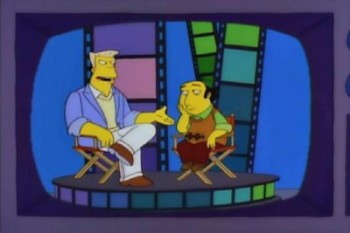 If everything went exactly as you would most like for you both career wise and writing wise, what would you be doing in five years?
If everything went exactly as you would most like for you both career wise and writing wise, what would you be doing in five years?
A profoundly dangerous question! I’m reminded of that Simpsons episode where someone asks McBain how he sleeps at night, and the answer is “On top of a pile of money, with many beautiful ladies.”
Really, though, I love being one of the folks in charge of Pathfinder, and I fully plan on sticking around and helping it grow as much as possible. If you had told me five years ago that we’d be the best-selling tabletop roleplaying game, I’d have laughed in your face. Yet now we’re licensing video games and comic books. It’s surreal. I meet fantasy celebrities like Brandon Sanderson and Patrick Rothfuss at conventions, and they’re like, “Oh, you work on Pathfinder? I love that game!” I feel like Tom Hanks in Big, like at any second somebody’s going to realize the charade and send me back to the kids’ table. But so far the bluff is working.
In terms of my own writing, in five years I’d love to have a creator-owned novel out there as well, but I wouldn’t be at all surprised if I were still writing Pathfinder novels and game books. I’m deeply proud of the work we’ve done so far, but there’s still a whole world that we’ve only just begun to explore…
When not working feverishly on innumerable projects, James Sutter can be contacted at his web site, or followed @jameslsutter or Facebook or G+. His newest novel is available here at Amazon, here at Paizo, and in bookstores nationwide.